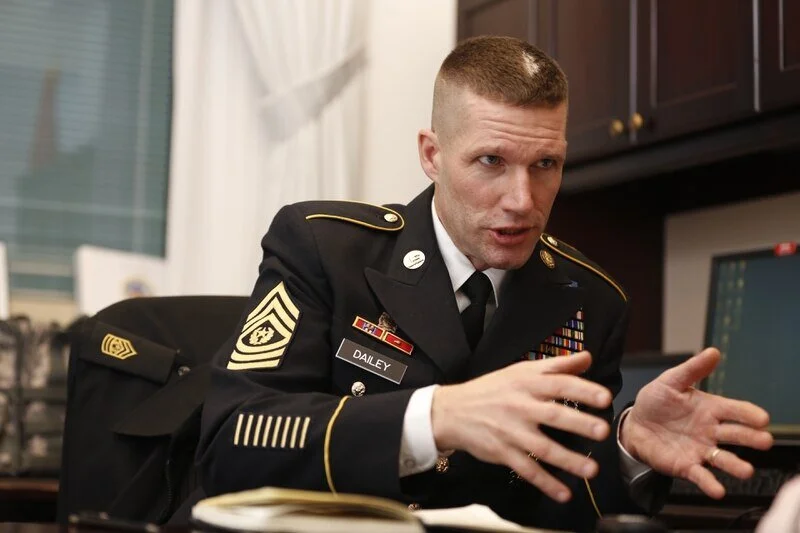Power belts, eye protection, and hand grenades — oh my! And all the sergeants major said, “Hell yeah!” While the staff sergeants rolled their eyes.
Let me explain.
In the Army, the senior enlisted service member of any (battalion-level or above) unit is the command sergeant major (CSM), the “Smaj” (rhymes with badge). But never call a CSM “Smaj” to their face.
The CSM has the most experience, has been around the longest, and is typically the oldest and most likely the crabbiest of all the soldiers in the unit. The CSM is typically around 40 with 20 to 22 years in service. They’ve seen it all. As top adviser and “Ranger buddy” to the commanding officer, they are big difference makers.
But why is the CSM crabby all the time? Well, because the CSM is typically roaming the unit area spot-checking for compliance to unit standards, which inevitably drives the staff sergeants (SSGs) bananas. They typically lead nine-soldier squads, composed of the SSG, two sergeants, and six soldiers. Squad leaders are the closest “leader of leaders” to the fight. They are tactically maneuvering fighting elements, are typically focused on the mission at hand, and tend to care little about the “rules” they feel don’t apply to them. The mean age is 25 with four to seven years in service.
The credo of the SSG is “Follow the rules you agree with.” If you don’t agree with it, change the standard when you’re out of sight, or claim “shooter preference” or “non-mission essential” when you’re caught outside of the standard. Better to ask forgiveness than permission.
This is the part that really chafes CSMs because “shooter preference” is typically soldier code for “I don’t wanna.”
But “shooter preference” conflicts with a standard if (and only if) someone is monitoring for compliance to the prescribed standard. And in the Army, someone is always watching for the standards because you cannot expect what you do not inspect. Any prescribed expectation left unmonitored is merely a suggestion, not a standard.
Blacksheep, A Co. 2/75 Ranger 1999. The typical response to powerbelts. This photo basically captures my 20’s. PS - the guy in the back walking between the platoons is most likely the CSM.
A lot of people don’t like being told what to do, even in the Army, which is why monitoring standards — especially safety standards — is important. Here are three examples that highlight three common categories of negative responses to prescribed safety standards:
Power Belts (Negative Response Category: “I don’t like” the safety standard)
Power belts are night reflectors that soldiers wear when running or ruck marching on the road. They are often part of the standard physical training (PT) uniform. Soldiers hate them.
I hated my power belt. Some of the more common affronts against the power belt are to claim “It’s not tactical,” or “It’s not like it’s car repellent,” or the ever famous “If I’m going to get hit by a car, I’m going to get hit by a car! This power belt is stupid!”
Looking back in my 40s, I know that as a young soldier I didn’t want to wear a power belt for two simple reasons: because someone told me to and because they look dorky.
I thought power belts were dumb until a Ranger on a tactical march got hit on a highway at night by a speeding car and was injured so badly it ended his military career. Turns out CSM was right about the power belts. Looking lame is a small price to pay for not getting run over.
Eye Protection (negative response category: “the safety standard impedes my ability to work”)
Ballistic eyewear that protects the eyes from debris and shrapnel — eye protection — is also infamous for capturing the heat and sweat coming off your face and fogging up to obstruct your vision. Typically, it happens right during the decisive point of the operation when you’re most amped up and your need to see the target is the most critical. It’s also typically the moment when you are most likely to encounter debris and shrapnel.
It’s not that eye pro is really hated, especially if you’re rocking Oakleys. In fact, though it was cool to rag on eye pro before the war, all of us got really happy about wearing our glasses once the GWOT started. Especially after that “wear your eye pro” photo with the 2-inch piece of shrapnel sticking out of the dude’s lens started circulating circa 2006.
I hate that photo because it made me love eye pro, and I had one less thing to drive the CSM crazy about.
This one! The worst!
Though I had good reason to pull off my eye pro from time to time to see the battlefield, my Oakleys saved my vision more times than I care to recollect, and I’m thankful to have my sight today.
CSM was also right about eye pro, but don’t tell him I said that. I have a reputation as a Ranger to uphold. Which leads me to hand grenades. (You’re welcome.)
Hand Grenades (Negative Response Category: “I don’t agree with” the safety standard)
This may be the trickiest category of all because it’s genuinely founded in a disagreement about right versus wrong. This is where thoughtful perspectives actually collide with one another creating friction if an idea becomes an ideology — a thought that becomes the fixation of the whole.
In 2002, Bagram, Afghanistan, was a tent city on an abandoned Soviet airfield surrounded by Hesco barriers and soldiers on guard. Down the center of the base, paralleling the airfield, was a long, hard-packed dirt road that we were authorized to run on when we left our corner compound.
When we ran on that road, we were required to have a weapon in hand. A weapon to run on a road surrounded by barriers and well-trained American soldiers guarding those of us inside the barriers.
I thought it was dumb, and I was willing to share my rationale.
Bagram 2002
Why would I need to shoot if we have soldiers on guard? Who am I going to shoot at on the inside of the base? If we are so overrun by the enemy that the guards have been eliminated, I’ll pick up an M4 and get to the fight. And most important, who the hell wants to run while carrying a gun?!?
Ultimately, the CSM was not persuaded by SSG Young’s thoughtful argument, and the safety standard remained in effect. So in one of my finest acts of smartassery, my squad and I complied — kind of.
After the weapons were issued, the boys and I went on a run, as prescribed, with one LAW (Light Anti-tank Weapon, a collapsible rocket launcher) tied up with a piece of 550 cord to one man’s back and eight M67 fragmentation grenades. Every hand had a weapon — a hand grenade.
We were pretty proud of ourselves. The CSMs on Bagram were not amused.
During the next rotation to Afghanistan, sometime in the middle of the night, we got attacked and a Hesco barrier saved many Rangers’ lives (including mine) by taking the full blast of the 107 mm rocket fired at us. I was pleased to have my rifle to return fire from the barrier, especially since none of the guards were reacting to contact. About two squads of Rangers were happy to oblige instead.
Obviously, being armed in the middle of a war is valuable, even if you’re surrounded by well-trained American soldiers. Someone (probably a CSM) made a decision — an unpopular one — about running with weapons that was founded in the best interests of all soldiers.
Lt. Col. Jacob White, commander of 2nd Battalion, 58th Infantry Regiment, talks with E Company soldiers after they received cloth face coverings from Combat Capabilities Development Command Soldier Center in Natick, Mass., April 27, 2020. Photo by Markeith Horace/Fort Benning Public Affairs Office, courtesy of DVIDS.
That’s the challenge with many safety standards, rules, and expectations that create some level of discomfort or disagreement. Many times safety standards feel ridiculous until the moment you need them and you discover why they exist in the first place.
It’s typically in those moments that SSGs and CSMs stop shaking their heads at each other and start thanking the Lord that one of their soldiers is still alive.
Today, I’m a little older, a little wiser, and a little less inclined to fight over something that someone else made a thoughtful decision about in the interest of others’ safety. I still may not “wanna.” It still might “impede my ability to work,” and I still “may not agree with it.” But these days I’m far more likely to just do it for a few reasons. It’s most likely not that big of a deal, it probably doesn’t really disrupt my life (or infringe upon my freedoms), and because I assume the person who made the decision most likely has more information than I do.
I’m still happy to submit a thoughtful response to rules that don’t seem to make sense, but I am more likely to comply with a safety standard because enduring a minor discomfort or inconvenience demonstrates more about my character than it does about anything else.
Namely, that I value discipline more than opinion, and compassion more than comfort.
In doing so, I’ve learned that it’s far better to be known for my character and my actions than for my attitude or opinions. And I’ve learned that showing respect for the governing authorities over minor inconveniences is a simple way to love others through my deeds, not my words.
This article was originally published on Coffee Or Die Magazine.
Cover Photo: Former Sergeant Major of the Army (SMA) Dailey (courtesy of Army Times).
Bonus Read: SMA Dailey's top 10 leadership tips for sergeants major.





